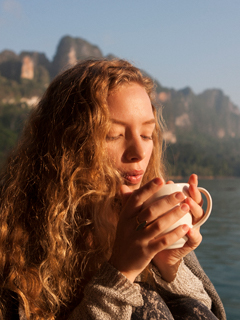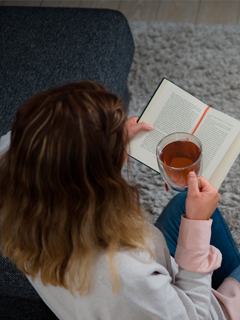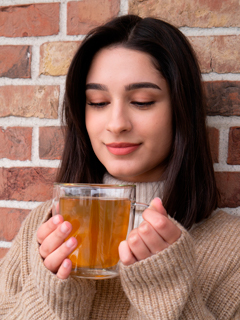FAQ - most frequently asked questions about tea
We are happy to answer your most frequently asked questions about tea and TeaGschwendner here. Please feel free to contact us directly if you have any further questions. Please use our guestbook or simply send us an email to teemail@teegschwendner.de.
We look forward to it!
What is the difference between green, black and oolong? Are they harvested from different plants?
Whether green, black, white or oolong - all teas come from the same plant. The differences lie in the processing of the tea leaves. White tea is only plucked and dried, green tea is heated to keep it green, black tea is fermented and oolong is partially fermented (so it is between black and green tea).
What are our low-tannin teas?
The content of ingredients is usually highest in the youngest leaves and the shoot. Quality teas from "2 leaves and a bud" have a correspondingly higher content of ingredients. Bancha and Kukicha are generally considered to be well-tolerated teas, as are Genmaicha (because of the rice content) and Keemun. Please note that the preparation is also decisive for the final content in the cup.
What are our low-caffeine teas?
Orthodox teas (green, black, white): Kukicha and Genmaicha consist of half stems and half rice respectively. In addition, the preparation plays a decisive role for the caffeine content in the cup. The hotter the water and the longer the brewing time, the more caffeine is dissolved.
All rooibos teas, honeybush teas, fruit teas and herbal teas, with the exception of mate, naturally contain no caffeine.
What do you recommend for a green tea beginner?
First of all, it is important to find out whether the Japanese (steam) or Chinese (hot pans) method is preferred. Japan Sencha No. 700 and China Lung Ching No. 519 can be recommended as teas for beginners. In this way, it is easy to find out which production method suits the beginner better.
How do the different Darjeeling First Flushes / Second Flushes differ, or what is the difference between First Flushes from Nepal, Darjeeling or Kangra Valley?
Every tea region and every tea garden has its very own signature, comparable to red wine. As with Bordeaux, for example, teas from the same region can be more floral or a little more pithy. In the case of Nepal and Kangra Valley, the different geography comes into play, which also contributes its own unique notes to the taste.
Can you rely on the organic label for the certified organic varieties?
Yes, you can. In addition to the certifications of the individual tea gardens, the head office in Meckenheim and each of our specialist shops are inspected every year. All inspections are carried out by independent inspection bodies.
How and how often are the organic gardens inspected within a year?
The tea gardens are inspected at least once a year. In addition, there are always unannounced spot checks by the inspection bodies. In most cases, certification is carried out by European inspection bodies (e.g. the IMO) to ensure the high standards.
How do organic/Naturland and Demeter labels differ? Are there differences in quality?
The differences lie in the slightly different criteria for certification. Naturland and Demeter are separate associations whose criteria differ slightly in some details. For example, Demeter makes it compulsory to use biodynamic preparations on a homeopathic basis, whereas the EU organic regulation does not. However, no statement can be made about the taste of a tea based on a seal alone.
Is black tea really an iron robber?
A scientific study by the University of Jena disproves this prejudice. Tea drinkers with sufficient iron supply need not fear iron deficiency. Even people with a critical iron supply do not have to do without the popular hot drink if they enjoy the tea one to two hours after meals. Then there is no danger that iron absorption will be impeded.
Does black tea have a calming effect when steeped for a long time?
The longer the tea brews, the more ingredients, including caffeine, are extracted. With increasing duration, however, other secondary plant substances are also dissolved, which delay the absorption of the caffeine in the body. Hypersensitive (particularly sensitive) customers should, however, avoid teas containing caffeine if in doubt.
Does drinking black and green tea count positively towards hydration?
A study by the Research Institute of Child Nutrition in Dortmund shows that tea drinkers are particularly well supplied with fluids. According to the study, women who drink tea regularly have a better fluid supply than women who do not drink tea. According to the study, black and green tea contribute significantly to fluid supply.
Why is the green tea Sencha more expensive than the Sencha (Gunpowder etc.) at the competition?
Sencha refers to a specific type of production and can be obtained from a wide variety of suppliers. Chinese Sencha, for example, is always cheaper than Japanese Sencha - but usually not as high quality. Furthermore, quality control and thus absolute trust in our teas play a major role. We guarantee the best and flawless tea enjoyment. We will gladly send you a residue analysis of your tea free of charge.
How and where is it best to store tea? Is it better if the tea is stored in a tin or is your packaging enough?
Tea is best stored in a cool, dry, dark and well-sealed place. Small quantities of tea can be stored in the TeeGschwendner tea bags. Larger quantities are best transferred to well-sealed containers. Tea should always be consumed as fresh as possible, so if in doubt, it is better to buy small quantities that are always fresh. Important note: store the Matcha tin in the refrigerator to keep the flavour fresh for longer!
Tea sommelier Gero Hartwig gives further tips on the best way to store tea in the Tea Taster Blog: https://www.teegschwendner.de/blog/wie-bewahre-ich-meinen-tee-am-besten-auf
Are children allowed to drink black tea or green tea?
It should be taken into account that tea from the tea plant (green tea, black tea, white tea, oolong tea) contains stimulating caffeine. Depending on the age, drinks containing caffeine are not recommended. Unsweetened fruit and herbal teas are excellent thirst quenchers for children.
You can read more about this topic in Daniel Mack's blog post: https://www.teegschwendner.de/blog/tees-fuer-kinder
Can tea go bad?
If stored correctly, black, green, white and oolong tea will not spoil. Fruit and herbal teas should not be stored longer than recommended beyond the best-before date. If stored in a cool, dry place, the tea will be good for 3 years. If the tea ever gets this old at home, perhaps the wrong type of tea has been bought :-)
Until when should tea be consumed without a loss of quality being evident?
Green tea, white tea and matcha get "old" faster than Assam teas, for example. If stored well, a loss of freshness is noticeable after about half a year, but the tea can be consumed over a much longer period without hesitation.
Which green or black tea do you recommend for hard water?
For hard water, we recommend black tea blends with a high proportion of Assam tea or Chinese green teas such as Mao Feng or Lung Ching. The finer the tea, the more impairment takes place through the water. In such cases, we advise using a water filter.
Do I have to throw away the first infusion of green tea?
This myth dates back to times with poor hygienic conditions. The tea could be contaminated with bacteria and since green tea in particular is not infused with boiling water, the first infusion was discarded in order to make a hygienically perfect second infusion. Nowadays, this is no longer necessary in any country of origin.
Can I brew green tea several times, and if so, how often?
Green tea in particular, but also oolong, is suitable for multiple infusions. The number depends on the quality of the tea (the higher the quality, the more infusions are possible) and on personal taste. As a rule, 2-3 infusions are no problem with most green teas.
And this is how it is done:
- Dose the tea as usual and prepare it according to the preparation recommendation.
- After the first infusion, all further infusions should be prepared with steadily hotter water. For example, if the first infusion is made at 70 degrees C, the second infusion should be made at a minimum of 75 degrees C. The infusion time can then be shortened by a quarter in each case.
- Allow as little time as possible to elapse between infusions. The tea leaves must not dry out. Especially moist, warm, steaming tea leaves in the kitchen should be handled with care. We recommend making the infusions within a few hours, but at least on the same day.
- Experience the many facets of the individual infusions, which even have their own names in some tea cultures (e.g. in the Japanese tea ceremony) and let your favourite tea enchant you again and again!
Can I brew black tea several times?
Theoretically, this is possible, but most of the aromatic substances of black tea pass into the first infusion, so that a second infusion usually tastes unusually flat and watery.
Why do you recommend not to infuse green tea with boiling water?
The bitter substances contained in green tea dissolve at temperatures above 80 degrees Celsius (depending on the variety). A green tea brewed with boiling water therefore tastes significantly more bitter than a green tea prepared with hot, no longer boiling water.
Why are there such big price differences?
That depends on many factors. It all starts with the cultivation, picking and processing. The more careful the work of the pickers, the higher the quality of the tea. Often, "cheap" tea is made from older leaves. The production of orthodox tea is still a craft today and requires a lot of skill. In addition, every tea from TeaGschwendner is controlled and tested far more strictly than is required by law. Last but not least, with the price we pay to the manufacturer, we want to help ensure that the pickers and tea farmers receive a fair price for their work!
What effect does tea have? Can I still fall asleep in the evening?
The effect of tea depends on the type and preparation, but varies from person to person. For the most part, tea has a stimulating effect. However, there are people who are highly accustomed to caffeine and who can sleep well even after drinking tea in the evening. Caffeine-free teas such as rooibos, herbal and fruit teas are very good alternatives for the evening.
If tea brews for more than 2 minutes, does it calm down?
The longer the tea brews, the more ingredients, including caffeine, are extracted. However, with increasing duration, other secondary plant substances are also dissolved, which delay the absorption of the caffeine in the body.
Is the positive tea effect influenced if you put milk or cream in black tea?
If you add milk or cream to the tea, there is a limited interaction between the tea ingredients and the protein in the milk. This may be noticeable in terms of taste, but otherwise not in any way. The positive influence of the tea is therefore fully preserved.
Is only green tea healthy?
Tea, unsweetened, is one of the most health-promoting foods of all. Tea from the tea bush Camellia sinensis has many beneficial ingredients - this applies equally to green, black, white or oolong tea. Many herbal teas and rooibos teas also contain beneficial essential oils and other ingredients that are good for the body.
What is stomach-friendly tea?
Many herbal teas are generally considered to be good for the stomach, such as fennel tea, camomile, sage etc. Rooibos is also easily digestible due to its ingredients. Acidic fruit teas should generally be avoided.
You can find a selection of low-acid fruit teas here: https://www.teegschwendner.de/Geschmack/Saeurearme-Fruechtetees/
Why does my tea taste bitter?
It could be that in the case of green tea, the water has been too hot. Or you have used unfiltered, hard water for the tea infusion? Use a water filter and/or reduce the amount of tea or the infusion time.
What are pyrrolizidine alkaloids and how are they to be evaluated?
All questions about pyrrolizidine alkaloids, their evaluation and the quality assurance measures of TeaGschwendner can be found in our flyer (in German) "Pyrrolizidinalkaloide".
What is TeaGschwendner's position on the Rosa Luxemburg Foundation's study of 09.07.2019 on working conditions in Darjeeling?
In July 2019, the Rosa Luxemburg Foundation published a study reporting on the working conditions of tea pickers in northern India. The tenor of the study is that tea traders, including TeaGschwendner, are not living up to their responsibility and should do more to improve working and living conditions in the Indian tea industry.
Like the authors of the study, we are very concerned about the living and working conditions of the tea pickers in the tea-growing regions. The German market and especially TeaGschwendner pays tens of times higher prices to the tea producers in order to enable a positive development of all those involved in the production. Since the beginning of our company's history, we have paid the highest and far above average prices directly to the tea gardens without intermediaries, in the case of Darjeeling Phuguri 20 times the purchase price to the average prices. In this way, we enable the tea garden owners to pay fair wages and to invest money in infrastructure, modernisation and social benefits for the tea workers. The wages of tea pickers in northern India have roughly doubled since 2013.
Of course, this is a development - with a lot of effort, we are working together with our long-standing partners in the growing countries and the certifiers such as Fairtrade, Naturland or Rainforest Alliance on a continuous improvement. As recently as the 1980s, 20% of Darjeeling gardens lay fallow and the pickers were unable to provide for themselves. The demand from Germany, especially for organic varieties, has created a new livelihood and perspective for many people in the region. In addition, organic cultivation has sustainable positive effects on the health of the pickers and the environment.
Our greatest respect goes to all those who, despite economic, political and social challenges, take responsibility for many people in the region by running a tea garden. We, as tea traders, make an important contribution to the further expansion of high-quality and ecologically compatible tea cultivation and social services such as school and medical care, provision of accommodation, life and health insurance and many more, within the scope of our possibilities by paying top prices for our products. If all traders worldwide paid purchase prices like we do with our comparatively small purchase volume, the wage level in Darjeeling could rise much faster.
From our point of view, the media coverage should include the positive development more in the evaluation and also consider the regional context instead of a comparison with western living and working conditions. When purchasing, TeaGschwendner concentrates as much as possible on friendly tea gardens or those that are certified by independent bodies such as Naturland, UTZ, Rainforest Alliance or TransFair. We also regularly check the conditions in the gardens from which we source tea on site.
In addition, we are focusing more and more on our own projects, such as the successful Sunderpani project in Nepal, because we can have a far greater direct impact on living and working conditions than is possible with traditional, union-controlled structures such as those in northern India, thanks to our close monitoring and great influence as a project partner.
Learn more about our project work in tea origin and beyond.



